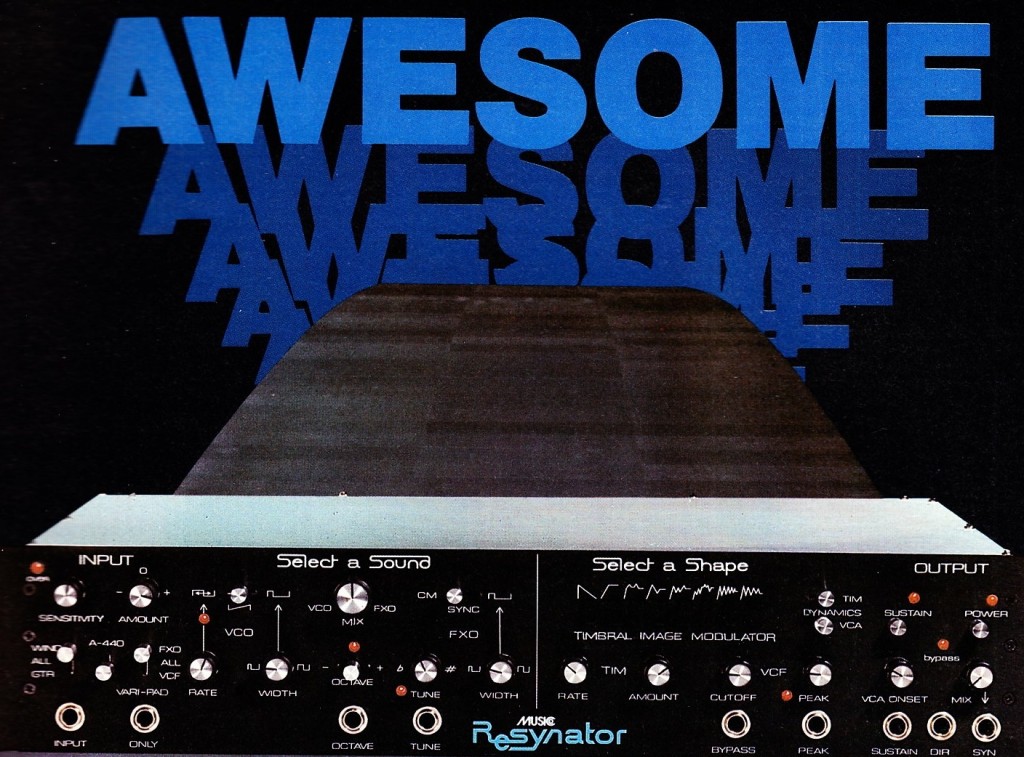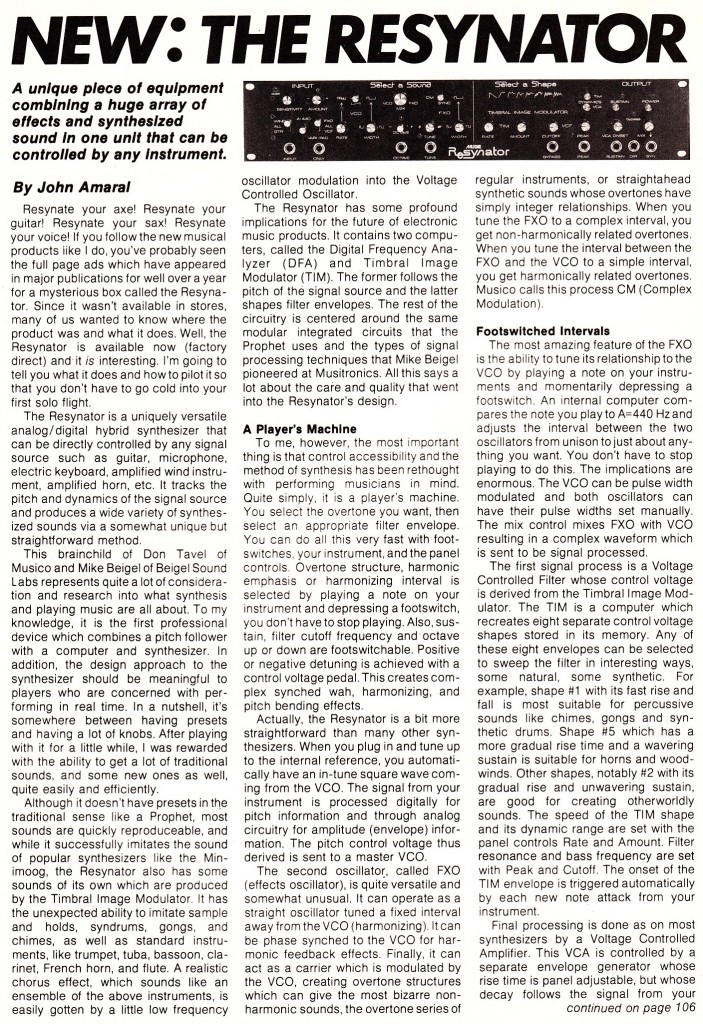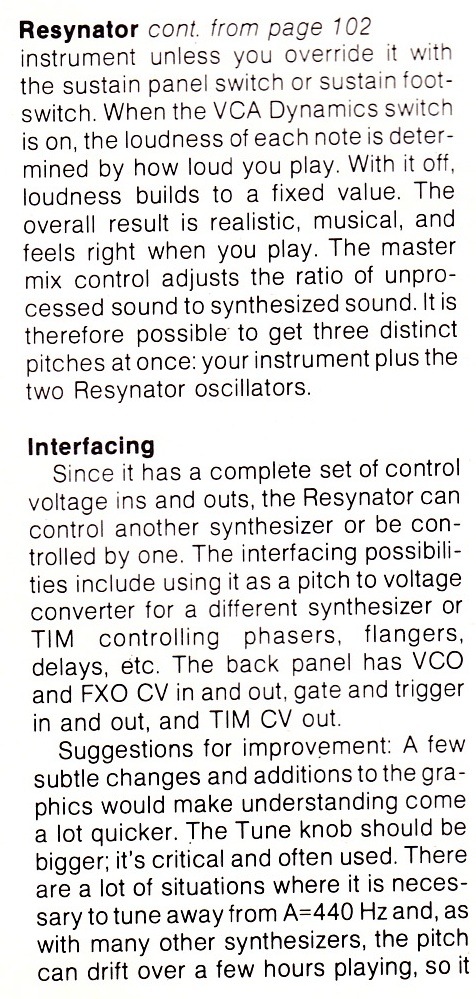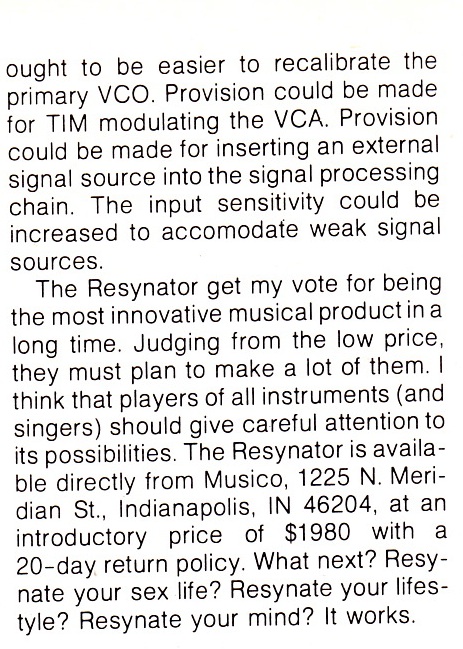 How y’all doing. Found an odd lil bit from 1980’s synth-land: the Resynator, from “Musico.” Yup that was the name of the company that created this $2000 device ($5,700 at the pump today, buddy). Anyhow, the Resynator is a fascinating pitch-and-envelope-tracking synthesizer (monophonic, I am sure) that used digital signal processing (unlike, say, the Korg MS20 of the same era, which could also track pitch and envelope, but was completely analog -and much cheaper). So, yeah, you could patch any monophonic audio signal into the Resynator and get a synth-sound on the output. But oh it’s so much more complicated than that. Read on, in this 1980 review by one John Amaral…
How y’all doing. Found an odd lil bit from 1980’s synth-land: the Resynator, from “Musico.” Yup that was the name of the company that created this $2000 device ($5,700 at the pump today, buddy). Anyhow, the Resynator is a fascinating pitch-and-envelope-tracking synthesizer (monophonic, I am sure) that used digital signal processing (unlike, say, the Korg MS20 of the same era, which could also track pitch and envelope, but was completely analog -and much cheaper). So, yeah, you could patch any monophonic audio signal into the Resynator and get a synth-sound on the output. But oh it’s so much more complicated than that. Read on, in this 1980 review by one John Amaral…
Categories



20 replies on “The Resynator pitch-tracking synth c. 1980”
Yeah. That’s the 2nd generation ReSynator. What Don Tavel simply called the “Rack Mount” version.
I worked with Don in Indianapolis as an engineer on the ReSynator project. As the review article stated, the legendary Mike Beigel did all the heavy-duty engineering on the Project at that point, but I provided engi engineering support and worked on Production setup for the ReSynator, created some custom hardware and wrote some specialized custom software to run Musico’s sophisticated “demo line”, and to help Don demo the ReSynator at NAMM and other trade shows and similar events.
The ReSynator was a WONDERFUL device, and I would LOVE to have one; but JUST as we were setting up for the first pilot production run of 100 units, Korg brought out the X-911 guitar synth,
While the Korg unit was inferior in almost every way (was really built around the guitar’s note-range (didn’t work for bass at ALL), hideous synthesizer section, cheap construction, etc.), it was “out” first, and it was $500, rather than the ReSynator’s $2k.
So, almost overnight, the wind went out of the sails at Musico, and the Pilot production run never got built, much less sold. I think there might be around 10 Rack Mount ReSynators around, plus Don’s 3 or so Prototypes, an unknown number of various generation prototypes at Beigel Sound Labs, and at least two of the Generation I “suitcase” version prototypes.
Interestingly enough, we used one of the suitcase versions as a “Bass Player” accompanist for Don (he was actually a very good guitarist) at trade shows. The “Bass Player” system used custom software written by yours truly for an Apple II, that drove a little digital oscillator, also of my design (woohoo) (that the ReSynator would then “track”). The software allowed Don to quickly put together songs from “Riffs” and “Progressions”, which was basically unheard of at the time. And in its spare time, the software also ran a big-screen TV with a “sales pitch” scrolling in big text. It really worked a treat!!! Wish I knew what happened to that software. I don’t have a copy of it that I know of, but today, there are a zillion things that will run in your iPhone that can do better…
Anyway, I can answer limited questions about the ReSynator, if anyone’s interested. Or, if anyone HAS a ReSynator they’d like to sell, by all means, let me know!
Wow doug great story. thanks for writing in. Well, i guess this explains why no one had ever seen one of these fascinating devices! Did you, Don, and/or mike go on to engineer any other notable hardware?
c.
Don unfortunately passed away due to a car crash about 17 years ago. I am fairly certain he had many other ideas (just one of those kind of people); but I don’t think he seriously pursued any of them.
Mike Biegel still does, or as of a couple of years ago, still did, do hardware engineering for himself and others. By the time I worked for Musico, Mike had already produced some of the most legendary effects devices, most notably, the incredibly popular Mu-Tron III envelope follower-filter (auto-wah) with his first company, Musitronics, and later for Roland and it’s subsidiary, Boss. Really nice guy, by the way!
As for me, I went on to have a career designing hardware and software for a variety of products, and for a variety of employers. But, other than an abortive attempt to bring a somewhat sophisticated stage lighting controller to market, none have been “entertainment” oriented.
As I said, I would LOVE to be my hands on a ReSynator; even though most of it’s functionality can be found in other hardware, and even purely software, offerings.
Good times, good times… 😉
Thanks for the info Doug – it’s great to have a record of this stuff.
Looking for a way to get back in touch with Doug McIntosh – Currently restoring the Resynator and Hexynator for Alison (Don’s daughter) to record music with bands. Any information would be appreciated!
alison@alisoninwonderland.com & mike@mu-fx.com
Doug McIntosh…. I have been looking for you for 30 years!!!
Hey Doug, my name is Alison – I am Don’s daughter. I would love to have a chat with you at some point about the Resynator among other things. Please let me know if you are able to connect. thanks!
I am Don’s brother and would like to get in touch with Doug McIntosh via email, which does not appear with his posts. I can be reached at LSTavel@gmail.com.
Thanks
Webmaster: Please correct my email address on the ReSynator post! SORRY!!!
Correct address is above.
There was also the Gentle Electric Model 101 Pitch and Envelope Tracker from the early 80s, which was entirely analog and still worked pretty well. Carl Fravel demonstrated the device for me where I worked at Don Wehr’s Music City in San Francisco. we compared it side-by-side with the Korg MS-20’s onboard P-to-V follower, and while it did a better job with low frequency signals, Carl explained why low pitches were harder to track for any P-to-V device – any system must allow a minimum of three waveform peaks to go through, with fairly exact spacing, for the circuit to decide it is a “pitch”. Low frequencies have longer spaces between peaks, hence longer “sample windows” and slower response times.
I still have an original MS-20 that I use to track the audio signal of a theremin, and it works uncannily well. Of course, a theremin’s output is very close to a pure triangle wave, so it’s easier to do than a guitar signal with all it’s harmonics.
While not a perfect device, “cheap construction” is not a charge I would level at Korg of the 1980s. The MS series of devices were built like tanks, compared to today’s standards. My MS-20 is over thirty years old and still works perfectly, tracks like a champ, and stays in tune.
My MS20 has held up really well too – stays perfectly in tune during long sessions, tracks pitch well, etc… which is much more than i can say for many synths of that era – Moogs and Rolands – that were either pitchy or stopped working. Every Juno 106 i ever had eventually broke, and my Jupiter 6 once had a $900 repair bill. Ms20 is still trucking, still making tracks – i like it so much that I recently bought the reissue as well, so that I could have one at the studio and one at home.
MS-20s stay in tune better due to the VCOs being V/Hz rather than V/Oct. Linear oscillators are inherently more stable. Which of course, makes it incompatible with most other analog synths. But I’ve been talking with the PAIA folks and apparently their Fatman synth is also V/Hz (linear is cheaper too) so I’m thinking of getting a Fatman as an outboard synth module/MIDI interface for the MS-20 (since you can’t find an MS-50 for less than four figures these days, and finding an MS-02 converter is like hunting for snipes.) I’m thinking of getting a new MS-20 Mini someday too, just for traveling (it’s not that big, but the old MS-20 is still kinda chunky to carry around, and I think it would prefer a sedentary life in my home studio.)
BTW, great site, Chris – I’m having a fun time exploring. Would you be interested in scans of old Altec (and some other company’s) catalogs and manuals? I’ve got a file cabinet full of them at work. I can send you a list of examples.
Wow thats interesting re the osc. I had not realized that.
So i guess i cant arpeggiate my ms20 from my arturia mini brute huh.
Thanks for yr offer re scans. Email me and lmk what you have. I have most of altec materials from the 50s and 60s, but if you have some interesting oddities that are not avail anywhere on the net, maybe we can run em here. C.
Actually, there are tricks to being able to run the MS-20 with arpeggiators/sequencers that use V/Oct scaling. You can use the “Total” input to the VCOs (the first jack, top left) which is actually exponentially scaled, rather than the CV In (on the right side). Then you have to tune the “T. Ext” modulation dial to adjust the scaling of the voltage being sent to the VCOs, which is a bit touchy, and usually only good for tracking within a <2 octave range.
Lots of nice MS-20 tricks here:
http://www.gotart.fr/bward/korgms/msmenu.html
And there are lots of mods that can be done, if you are (and I assume you are) handy with a soldering iron:
http://www.cykong.com/Synths/Korg%20MS-20/KorgMS-20.htm
v v interesting, thanks. gonna check that link… c.
THANKS to “Chris”, John Amaral, for bringing to light the remarkable Analog-Digital Resynator Instrument-Controlled-Synthesizer (and especially to Doug McIntosh (for promoting me to “legendary” status)
FACTOID: In the music business folklore of the 1970’s and early 80’s there was a funny expression used for chiding people who became infatuated with their own accomplishments: the expression was “He’s a legend in his own mind.”
So much for “legendary” status 😉 but Thanks Doug, I felt great till I realized that I felt “great”! ha ha
Also, though Roland did seem to pay the Musitronics products the highest respect by “emulating” a number of our products, I never personally (intentionally) worked for Roland or Boss.
However I did do some projects for Unicord and it’s (then baby elephant) Korg, and St. Louis Music, and some other companies in the music business. After quite a few years I also did some product designs for Musitronics Corp’s former arch-rival Electro Harmonix (on and off from 1996 to 2011).
And now, to avoid (it is hoped) the mental deterioration of semi-retirement, last year I set about ‘re-inventing” products from the high priced vintage Original Musitronics Mu-Tron line and introduced in October 2013 the first product(and first of a new product line) is called the Tru-Tron 3X, made in the USA by Mu-FX, a division of Beigel Sound Lab.(Established 1971 to make….Synthesizers.)
I was unable to fully utilize the legacy of the fine reputation of the “Mu-Tron” name, on account of some silly mistakes by an ethically-challenged former Musitronics employee.
But i hope the new Mu-FX /Beigel Sound Lab products will speak for themselves in terms of sound quality, design integrity and creativity, and high-end quality control.
We have already got many great demos from some original Mu-Tron endorsers, and even hi-profile NEW endorsers like Bootsy Collins. I also recently sent 3 Tru-Trons to the VERY legendary “boy Wonder” Superstar of the 70’s to the present.
So…….The Mu-FX project was and is already in full-swing, when …
to my amazement I received a communication from Alison Tavel, (Don Tavel’s grown up daughter), a full generation in years after the design and construction of the (very few RESYNATOR instrument-controlled one-voice synthesizers and the “one -off” HEXSYNATOR six voice guitar synthesizer). Somehow both items had been preserved over those many years and Alison managed to gather various dispersed parts of the Res/Hex/synators, materials and documentation.
Today (August 2, 2014) Alison brought all of these items down to my lab near San Diego– for refurbishing and restoration to musical operation. Thank goodness the documentation was fairly well preserved.
This could be construed as very serious example of “what goes around comes around”!!! Or maybe it was just improbability theory at work again.
And I am glad that I am still “around” to make Don’s brain-children “sing” again, for his daughter and–Who knows who else will try these unusual and creative “lost products from another age”. Strange but true, true, true.
Mike Beigel
I just added a featured page on the Resynator, with links to a new Go Fund Me campaign, video demos, and extracted text from the images of the review included here:
http://www.joness.com/gr300/Resynator_Hexsynator_vintage_analog_synth_musico.htm
Check it out, Alison is moving ahead with her project!
To Mike Beigel,
I had a Mu-Tron III. Thank you. It made me funky.
I stumbled upon this thread after following the rabbit hole links in Alison’s crowd-funder, and this is the very first time I’d even heard of the legendary Mike Beigel and Musitronics – but, I ‘invented’ a stereo rackmount envelope follower/gate > VCF > VCA effects unit in the 1990’s – called the ‘Mutator’. It also had a side-chain input so you could use the dynamics of one sound (eg drum loop) to control the filter cut-off and/or amplitude dynamics of another – in stereo- with 2 multi-waveform lfos that could be synced to MIDI clock. It was originally intended for seriously warping the techno-trance remixes of the time – which it succeeded in doing but it also ended up all over various Radiohead and William Orbit albums (including the one he did for Madonna – lol!) Me and my ‘business partners’ never made any money out of it (long story there 🤣) but the really spooky things is we called the company Mutronics ….. and we’d never heard of you before……
Hi Nigel. I feel like I remember seeing one of these for sale at Rogue Music on 30th st in Manhattan back in the 90s… and being confused by the name, as it reminded me of musitronics ETC… is this possible? Did ur machines make it to stores in the states?